SPARQL Tutorial
August 23rd, 2018
Wouter Beek (wouter@triply.cc)


Part I: The first SPARQL query
The first SPARQL query
select * {
?s ?p ?o.
}
limit 5select *- Projection: the variables whose bindings
are returned (result set).
*means bindings for all variables are returned. { ?s ?p ?o. }- The graph pattern that is matched. Variables start with a question mark.
limit 5- Modifier over the result set: only show the first 5 results.
Make the graph pattern more specific
select * {
?image <https://triply.cc/rce/def/locator> ?url.
}
limit 5<https://triply.cc/rce/def/locator>- Instantiate variable
?pwith an IRI. ?imageand?url- Use descriptive names for variables .
Change the projection
select ?url {
?image <https://triply.cc/rce/def/locator> ?url.
}
limit 5?url- Only return the bindings for
?urlin the projection. ?image- A hidden variable: one that is not returned.
Introduce variables with bind
select * {
?image <https://triply.cc/rce/def/locator> ?url.
bind(concat('<a href="',?image,'"><img src="',?url,'"><a>') as ?widget)
}
limit 5bind(EXPRESSION) as ?x- The result of evaluating
EXPRESSIONis bound to?x. concat(STRING,…)- Evaluates to a concatenated string.
Change the limit
select * {
?image <https://triply.cc/rce/def/locator> ?url.
}
limit 6Add an offset
select * {
?image <https://triply.cc/rce/def/locator> ?url.
}
limit 5
offset 5offset 5- Skips the first 5 results, returning the 6th through the 10th result.
Part II: Graph patterns
Graph pattern (2 triple patterns)
select * {
?image <https://triply.cc/rce/def/locator> ?url.
?image <http://xmlns.com/foaf/0.1/depicts> ?monument.
}
limit 5?image- A shared variable connects two triple patterns. Connected triple patterns form a graph pattern.
Graph pattern (3 triple patterns)
select * {
?image <https://triply.cc/rce/def/locator> ?url.
?image <http://xmlns.com/foaf/0.1/depicts> ?monument.
?monument <http://www.w3.org/2000/01/rdf-schema#label> ?label.
}
limit 5http://xmlns.com/foaf/0.1/depicts- Friend of a Friend (FOAF)
http://www.w3.org/2000/01/rdf-schema#- RDF Schema (RDFS)
Graph pattern (4 triple patterns)
select * {
?image <https://triply.cc/rce/def/locator> ?url.
?image <http://xmlns.com/foaf/0.1/depicts> ?monument.
?monument <http://www.w3.org/2000/01/rdf-schema#label> ?label.
?monument <https://triply.cc/rce/def/bouwjaar> ?year.
}
limit 5Sort by year (oldest first)
select * {
?image <https://triply.cc/rce/def/locator> ?url.
?image <http://xmlns.com/foaf/0.1/depicts> ?monument.
?monument <http://www.w3.org/2000/01/rdf-schema#label> ?label.
?monument <https://triply.cc/rce/def/bouwjaar> ?year.
}
order by ?year
limit 5order by ?x- Orders results by the bindings of
?x.
Sort by year (newest first)
select * {
?image <https://triply.cc/rce/def/locator> ?url.
?image <http://xmlns.com/foaf/0.1/depicts> ?monument.
?monument <http://www.w3.org/2000/01/rdf-schema#label> ?label.
?monument <https://triply.cc/rce/def/bouwjaar> ?year.
}
order by desc(?year)
limit 5order by desc(?x)- Inversely orders results by the
bindings of
?x.
Use abbreviations
prefix foaf: <http://xmlns.com/foaf/0.1/>
prefix rce: <https://triply.cc/rce/def/>
prefix rdfs: <http://www.w3.org/2000/01/rdf-schema#>
select * {
?image rce:locator ?url;
foaf:depicts ?monument.
?monument rdfs:label ?label;
rce:bouwjaar ?year.
}
order by desc(?year)
limit 5prefix ALIAS: <IRI>- Allows
IRIto be abbreviated withALIAS+ colon. ;after an object term- Means that we implicitly repeat the subject term.
Part III: GeoSPARQL
Linked Geodata
prefix geo: <http://www.opengis.net/ont/geosparql#>
select * {
?monument geo:hasGeometry ?geometry.
?geometry geo:asWKT ?shape.
}
limit 1000-
geo:hasGeometryandgeo:asWKT - GeoSPARQL, standardized by the Open Geospatial Consortium (OGC).
Property Path notation
prefix geo: <http://www.opengis.net/ont/geosparql#>
select * {
?monument geo:hasGeometry/geo:asWKT ?shape.
}
limit 1000p/q- Means follow property
pand then propertyq(and do not bind the node in between).
Federated query
prefix geo: <http://www.opengis.net/ont/geosparql#>
prefix owl: <http://www.w3.org/2002/07/owl#>
select * {
{
select * {
?monument geo:hasGeometry/geo:asWKT ?shape1;
owl:sameAs ?pand.
}
limit 10
}
service <https://data.pdok.nl/sparql> {
?pand geo:hasGeometry/geo:asWKT ?shape2.
}
}- Sub-select
- First the inner query is performed, and then the outer query is performed.
service <IRI> { QUERY }- Execute
QUERYon endpointIRI.
Complex data model
prefix bag: <http://bag.basisregistraties.overheid.nl/def/bag#>
prefix geo: <http://www.opengis.net/ont/geosparql#>
prefix rdfs: <http://www.w3.org/2000/01/rdf-schema#>
select ?shape {
service <https://data.pdok.nl/sparql> {
?woonplaats rdfs:label "Amsterdam"@nl.
?openbareRuimte bag:bijbehorendeWoonplaats ?woonplaats;
bag:naamOpenbareRuimte "De Boelelaan".
?nummeraanduiding bag:bijbehorendeOpenbareRuimte ?openbareRuimte;
bag:huisnummer 1105;
bag:postcode "1081HV".
?verblijfsobject bag:hoofdadres ?nummeraanduiding;
bag:pandrelatering ?pand.
?pand geo:hasGeometry/geo:asWKT ?shape.
}
}
limit 1Large-scale queries
prefix bag: <http://bag.basisregistraties.overheid.nl/def/bag#>
prefix geo: <http://www.opengis.net/ont/geosparql#>
prefix xsd: <http://www.w3.org/2001/XMLSchema#>
select ?shape ?shapeLabel {
?verblijfsobject bag:hoofdadres/bag:bijbehorendeOpenbareRuimte/bag:bijbehorendeWoonplaats/bag:naamWoonplaats "Apeldoorn"^^xsd:string;
bag:pandrelatering ?pand.
?pand bag:geometriePand/geo:asWKT ?shape;
bag:oorspronkelijkBouwjaar ?shapeLabel.
}
order by asc(?shapeLabel)
limit 50Geo-3D query
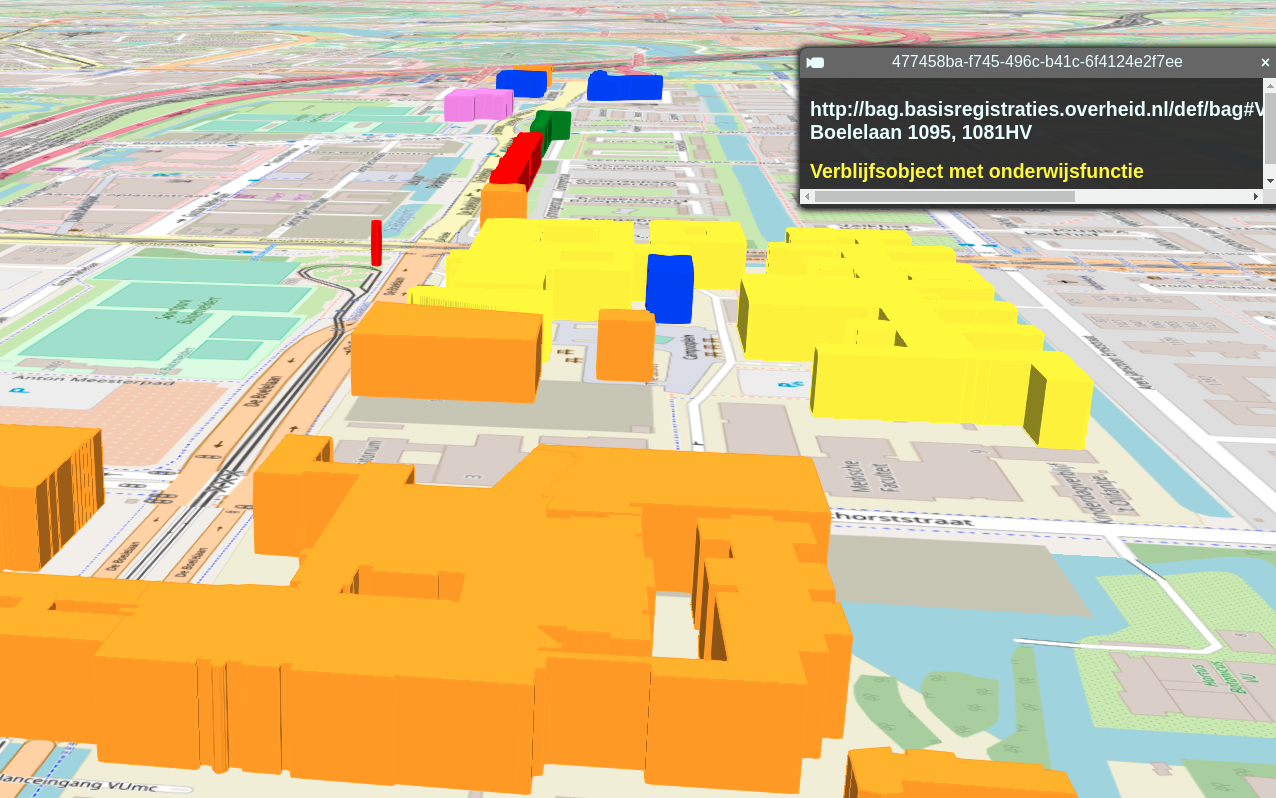
- Living space
- Shopping
- Offices
- Education
- Health
- Sport
Average building values (WOZ)
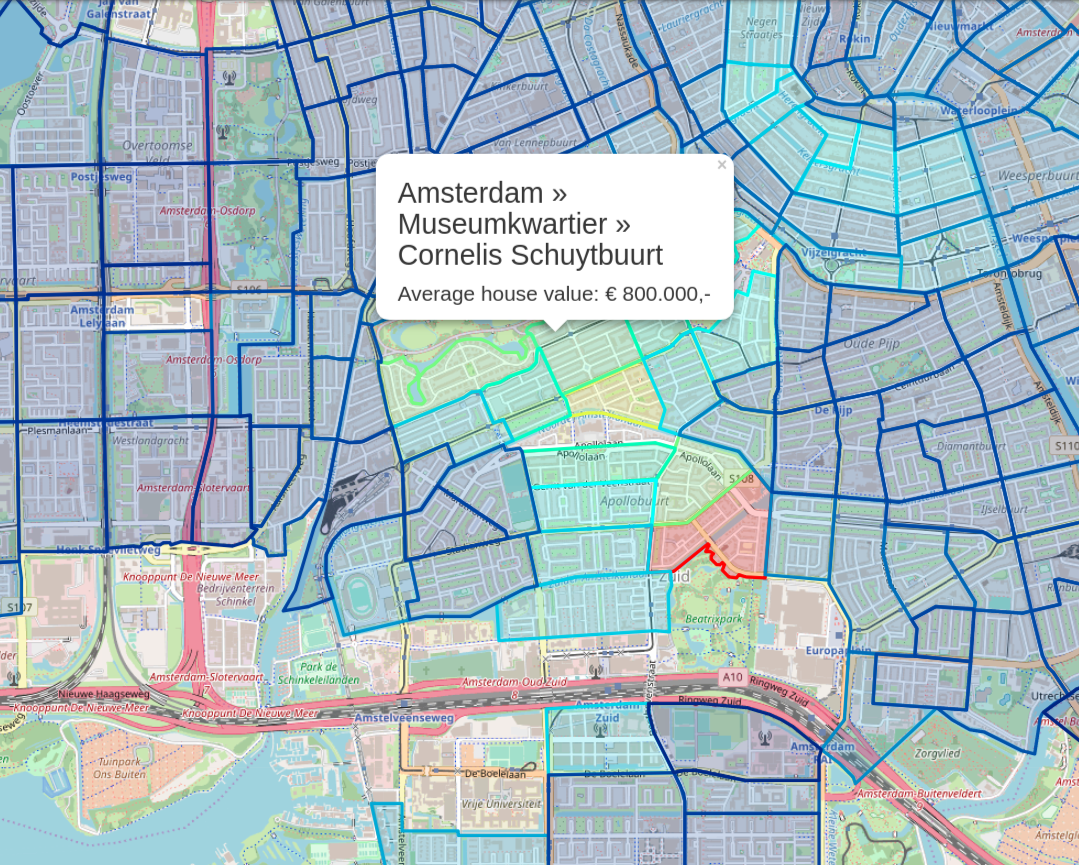
Querying 4 datasets
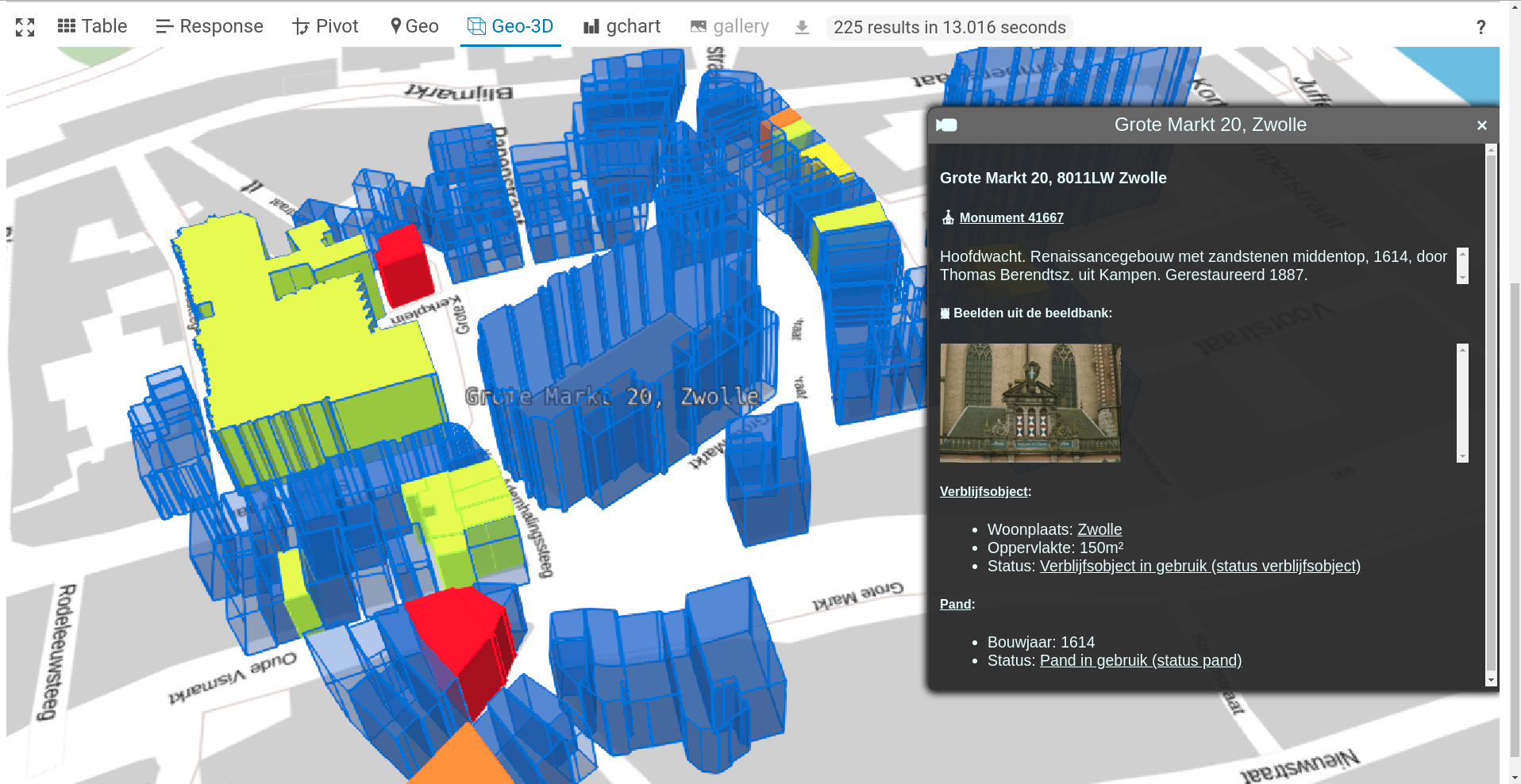
- Kadaster
- BAG
- Kamer van Koophandel (KvK)
- Bedrijfsvestigingen
- Rijksdienst voor het Cultureel Erfgoed (RCE)
- Monumentenregister & Beeldbank
- Rijksdienst voor Ondernemend Nederland (RVO)
- Energielabels
Part IV: Querying the LOD Cloud
Linked Open Data Cloud
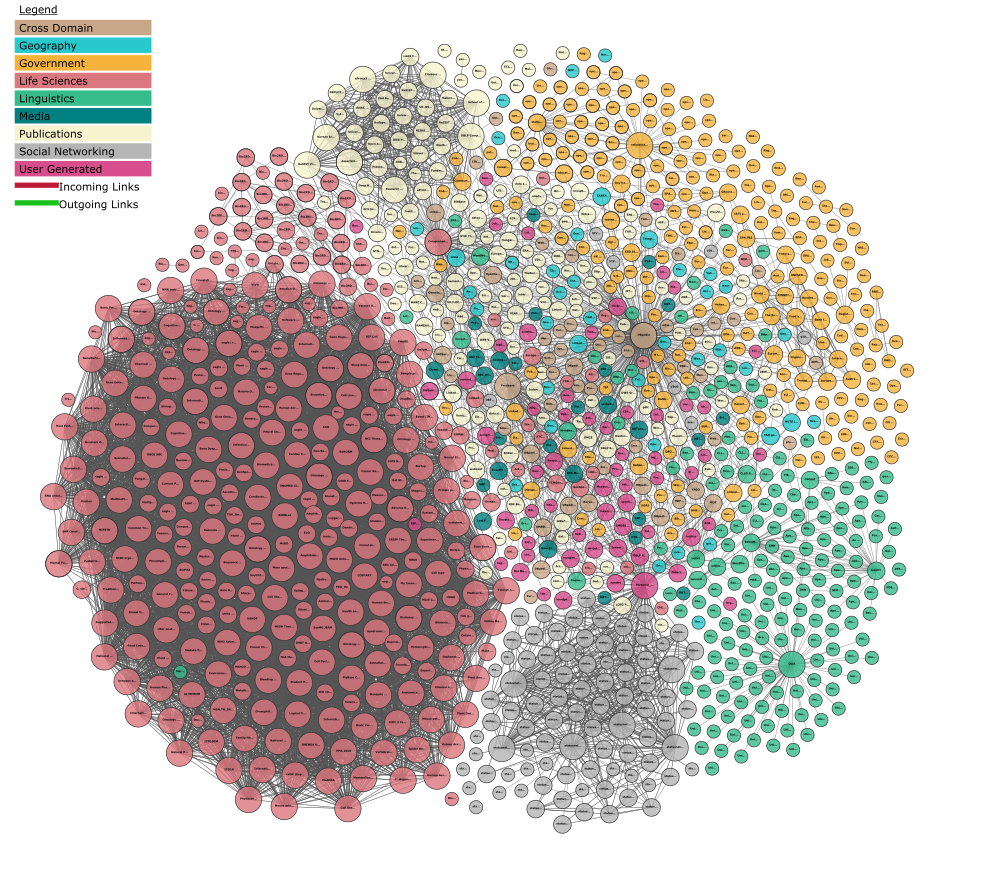
Dutch municipality → DBpedia 🕸
prefix brt: <http://brt.basisregistraties.overheid.nl/def/top10nl#>
prefix foaf: <http://xmlns.com/foaf/0.1/>
prefix geo: <http://www.opengis.net/ont/geosparql#>
prefix rdfs: <http://www.w3.org/2000/01/rdf-schema#>
prefix xsd: <http://www.w3.org/2001/XMLSchema#>
select ?shape ?shapeLabel {
?place1 brt:isBAGwoonplaats true;
geo:hasGeometry/geo:asWKT ?shape;
rdfs:label "Swalmen"^^xsd:string.
service <https://dbpedia.org/sparql> {
?place2 foaf:depiction ?vlag;
rdfs:label "Swalmen"@nl.
}
}
limit 1
service <URL> { A } means that
subquery A is executed on a different
SPARQL endpoint. The results are received from that
endpoint, and integrated within the overall query
results.
Apeldoorn does not have a flag
prefix brt: <http://brt.basisregistraties.overheid.nl/def/top10nl#>
prefix foaf: <http://xmlns.com/foaf/0.1/>
prefix geo: <http://www.opengis.net/ont/geosparql#>
prefix rdfs: <http://www.w3.org/2000/01/rdf-schema#>
prefix xsd: <http://www.w3.org/2001/XMLSchema#>
select ?shape ?shapeLabel {
?place1 brt:isBAGwoonplaats true;
geo:hasGeometry/geo:asWKT ?shape;
rdfs:label "Apeldoorn"^^xsd:string.
service <https://dbpedia.org/sparql> {
?place2 rdfs:label "Apeldoorn"@nl.
optional { ?place2 foaf:depiction ?vlag. }
}
}
limit 1
When you query the web, not all information is there all
the time. optional { A } makes the query
resilient against missing information.
Population density
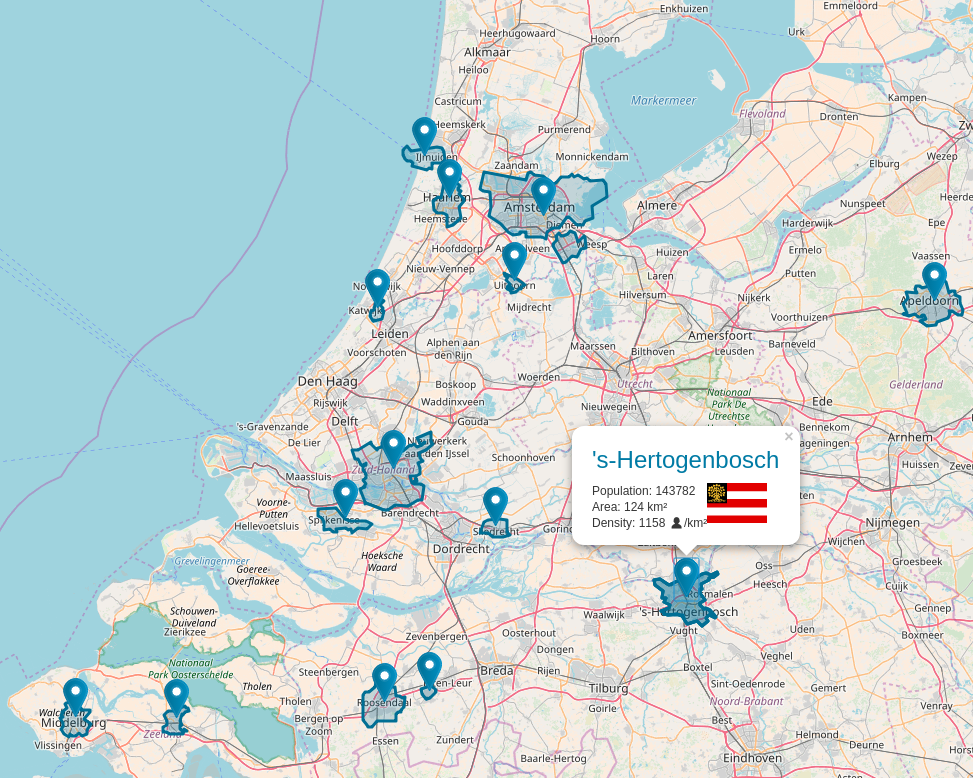
Thank you for your attention!
- WWW: test.triply.cc
- Email: wouter@triply.cc
- Twitter:
@WGJBeek

